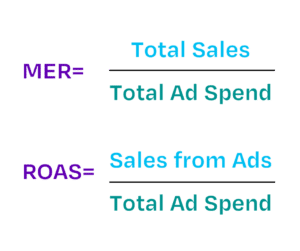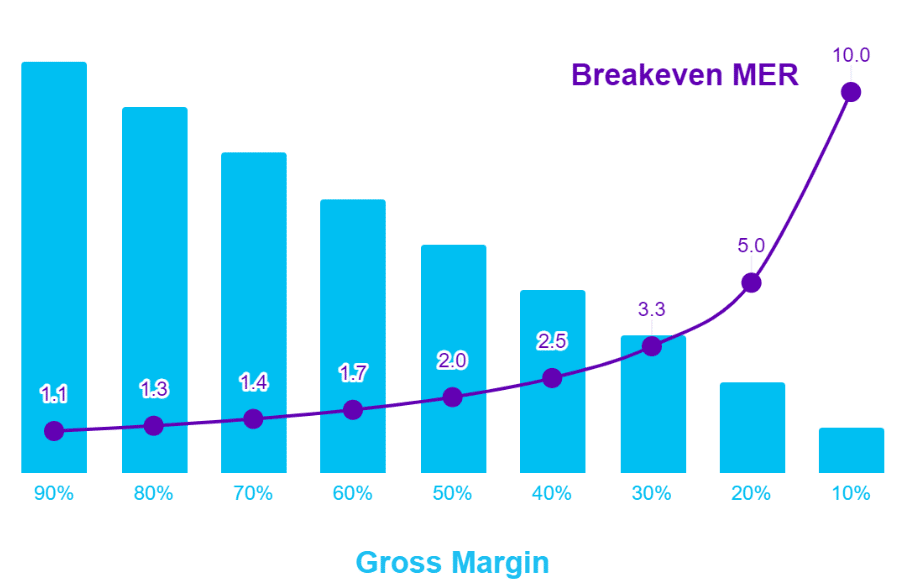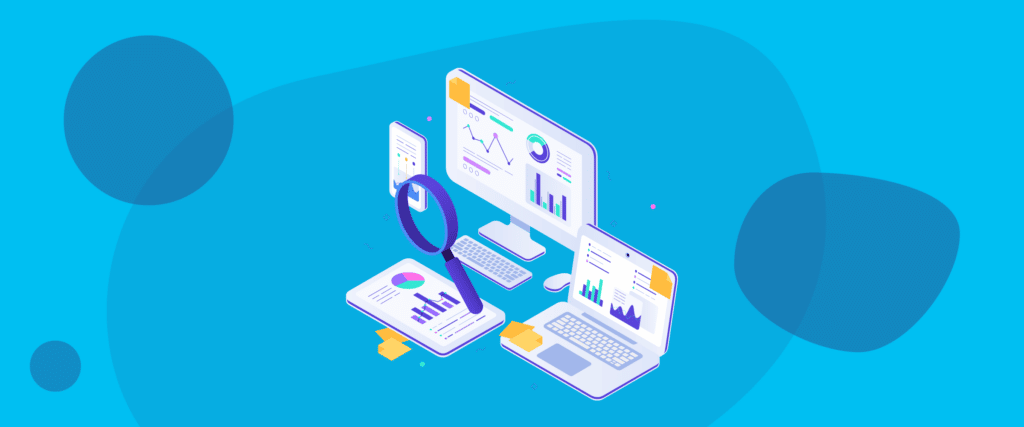Marketing Efficiency Ratio (MER) is a key metric in your business and is calculated as Total Sales / Total Ad Spend in a given period. In effect, MER is a measure of the efficiency of your digital marketing spend in driving revenue. The higher the MER the more efficient is your advertising. MER is critical for Shopify merchants as it is a key indicator of how ready you are to scale your business.
MER is different from ROAS (Return on Ad Spend) in one critical way. While ROAS measures the efficiency of advertising in relation to sales that are directly attributable to ads, MER looks at the relationship between overall sales and advertising. MER enables you to overcome many of the issues associated with correctly attributing sales to ads run across different ad channels. ROAS is useful for analyzing the direct returns from your advertising in the short term while MER helps you understand better longer term performance of your Shopify store.
What is a good MER for a Shopify merchant today?
The MER for your business will depend on a number of factors and, therefore, it is not easy to compare yourself with others. However, a recent research report across 5,000 eCommerce stores suggests that the average across all sizes and categories is a MER of 6.36. That means, for every $1 of ad spend, merchants are achieving $6.36 in total sales in their stores.
How to calculate MER
Calculating and monitoring MER on an ongoing basis can be time-consuming. It involves retrieving your store sales data and dividing it by the sum of ad spend from across different ads channels, for a given period. Optily’s free-to-install app, Optily – Sales Supercharger, calculates MER for you and enables you to analyze how it is trending over time.

Some people wonder why MER takes into account all sales and not just sales from new customers. Today, most successful DTC merchants are leveraging the full suite of marketing tools to attract, convert, and retain customers. ROAS does a good job of helping you to understand the performance of ads in a very narrow sense – sales directly attributable to ads in the past 30 days. MER helps you understand not just how efficient you are at acquiring and converting customers but also at retaining those customers over longer periods of time.
How to improve MER?
The most impactful thing you can do on a daily basis to improve your MER is to ensure your investment in ads is being actively managed across the multiple ad auctions you are using. For example, most merchants are typically running several sales and/or catalog campaigns across Meta (Facebook, Instagram), Google (Shopping & YouTube), and, increasingly, TikTok. Spotting opportunities to improve the performance of your spend on those sales campaigns can have the most dramatic impact on your advertising efficiency.
Merchants often struggle with scaling profitable ad campaigns. For example, if you are achieving a ROAS of 10 on existing sales campaigns, simply investing more in those campaigns doesn’t always lead to increased sales. Without investing in upper-funnel ad strategies to grow awareness and drive qualified traffic to your store, you’ll quickly see your marketing efficiency decline. Read more about developing full-funnel marketing strategies in our guide.
Since MER is calculated as the ratio between total store sales (regardless of marketing source) and ad spend, it is clear that improving the performance of other aspects of your marketing will help to improve your MER. If most of your ad spend is currently focused on acquiring new customers, then investing more time in converting and retaining those customers will ensure that you achieve a better return from your acquisition marketing efforts.
The data demonstrates that this is often the case. More well-established stores can expect to achieve a higher MER. The TripleWhale research demonstrated that stores with annual revenue between $10-25m were achieving a MER of 14.8 on average. We can understand that this makes sense since these stores will have greater brand recognition and are likely to have robust customer retention strategies in place. Investing more of your advertising budget, in conjunction with other marketing efforts, to reignite your existing customer base is a great way to maximize the returns for your store.
Knowing When to Scale with MER
MER is very useful for you to understand the overall profitability of your Shopify business and gives you the information you need to decide if you are ready to scale. If you are already in high growth mode, then MER helps you to monitor the effectiveness of your marketing efforts to ensure you don’t dip into unprofitable activities.
Analyzing your MER with your Gross Margin is the key to understanding if you have a profitable business that is ready to scale further. Remember, Gross Margin is ([net sales – cost] / net sales) * 100. If your net sales is $100,000 and your cost is $40,000, then your Gross Margin is 60%.

For a scalable business, we need to ensure that our marketing costs do not exceed our Gross Margin. MER is perhaps the easiest way to track this and ultimately guide your investment decisions. For example, if your Gross Margin is 50%, then the MER breakeven point is 2.0. With a MER of 2.0, for every $1 in ad spent, you are achieving $2 in total revenue. Your gross margin on that $2 is $1 ($2 * 50%), therefore you are at breakeven point.

This chart highlights the MER Breakeven Point based on your store’s Gross Margin. As we can see this doesn’t scale uniformly. The higher your Gross Margin the less incremental is your MER Breakeven Point. The MER Breakeven Point difference between a store with a 90% and 80% Gross Margin is 0.2 (1.1 versus 1.3).
However, for stores with lower margins, there is a much greater pressure on marketing to deliver high efficiency. A store with a 20% margin needs to achieve a MER of 5.0 to break even. However a store with a margin of 10%, requires a MER of 10.0, which is a massive leap from an operational perspective.
Conclusion
If you’re a Shopify business owner, keeping track of your MER is really important. It is a good gauge of where your business is at and can help you know when it’s time to scale.
With the new Optily Shopify app, you can track your MER and much more. Start optimizing your online ads for free today with our 14-day trial.







